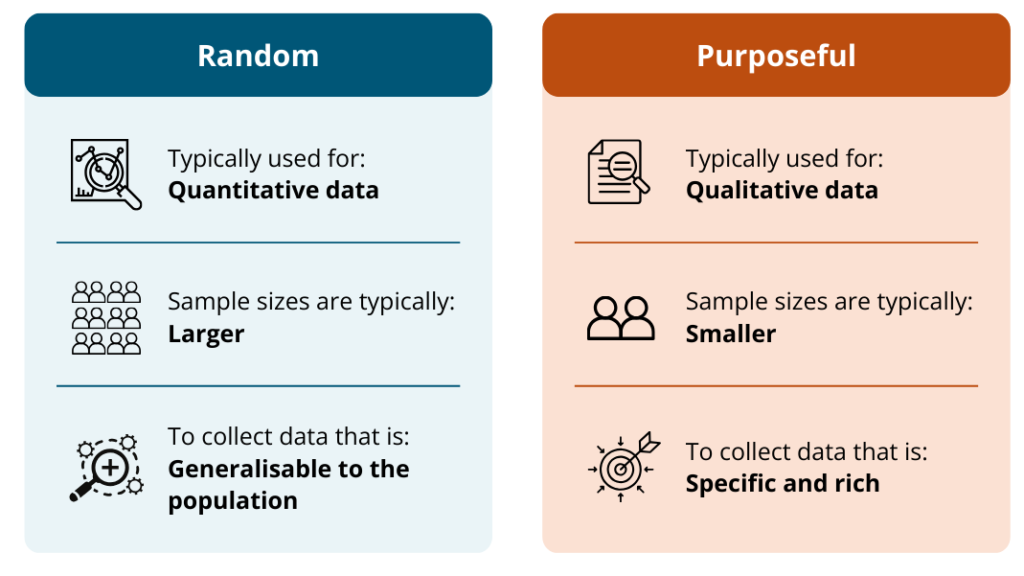
Sampling with purpose: 7 approaches for qualitative research
Imagine yourself as a fruit grower. It’s been a great season, and your trees are abundant with apples, peaches, and plums. One day you decide to pick some fruit to make homemade jam. With so many fruits to choose from, how do you decide which fruits to use?
This question is essentially one about sampling.
There are two ways to approach sampling: random or purposive. As the name suggests, random sampling involves selecting participants from a population randomly. With a sufficiently large sample, we can generalise our findings about the sample to the population. We know this is true because of probability theory and the central limit theorem (thanks to our dear old friend, the normal curve).
Random sampling is most common when collecting quantitative data. With quant data, we’re typically aiming to make empirical generalisations by controlling for selection bias.
How we approach qualitative sampling is quite different. With qual data, we’re typically aiming to identify and study information-rich cases that yield insights and in-depth understanding. These samples are selected purposefully. What would be considered bias in random sampling becomes intentional in purposive sampling.
Purposeful sampling: “a method by which units are selected to be in a sample by a deliberate method that is not random” (Shadish et al., 2002).

Returning to our fruit grower analogy, how would you decide which fruits to use?
Let’s say you want to make a jam that most accurately reflects the orchard in its entirety. To do this, you randomly select 100 fruits. Because each fruit has an equal chance of being selected, the relative proportion of fruits in the jam is equal to the relative proportion of fruits in the orchard.
But maybe you decide to make a specific type of jam. This would involve selecting fruits purposefully – that is, based on certain criteria, rather than randomly. Those criteria would be based on characteristics of the fruit that influence the jam (e.g., type of fruit, variety, age, etc.). The criteria used to select fruit would depend on the type of jam we want to make.
The same logic applies to sampling in qualitative research. The criteria we use to determine our sample will depend on the type of information, perspectives, and insights we wish to generate.
There are many ways we can sample purposefully. Here are 7 different approaches suggested by Michael Quinn Patton in his tome on qualitative research methods.[1]
Purposeful sampling
Extreme or deviant case sampling involves selecting cases that are information rich because they are highly unusual or special in some way. The logic of extreme case sampling is that focusing on exemplary cases will generate unique insights that cannot be obtained by studying typical or average cases. Such an approach can be useful for identifying factors that lead to success, failure, or both.
Intensity sampling involves selecting cases that are unusual, but not quite at the extremes. The logic of intensity sampling is that extreme cases may be too unusual to yield useful information. Like extreme case sampling, this approach can be useful for identifying factors that lead to success or failure.
Typical case sampling involves selecting cases that are “average” – in other words, they are not atypical or unusual. Typical cases can be selected using any data that provides a normal distribution. This approach can be useful for illustrating what is typical to those unfamiliar with the program.
Maximum variation (heterogeneity) sampling involves selecting cases that maximise the diversity of the sample on certain characteristics such as age, gender, or geographic location. This approach can be useful for identifying themes and experiences that are common across diverse individuals, as well as themes unique to particular sub-groups.
Minimum variation (homogenous) sampling is the opposite of heterogeneous sampling. This approach involves selecting cases that are as similar as possible on certain characteristics of interest. This approach can be useful for gathering in-depth information about a particular sub-group. This approach is often used when sampling for a focus group that seeks to bring together people of similar backgrounds and experiences.
Snowball sampling involves asking participants to help identify other potential subjects. This approach can be useful for locating information-rich cases. Key names that are mentioned repeatedly by program stakeholders are likely to be knowledgeable, and potentially worth talking to. It is also a useful strategy for finding more participants when recruitment is difficult.
Convenience sampling involves selecting cases that are easiest to access. This approach is least desirable as it is neither purposeful nor strategic.
Takehomes

[1] Patton, M. Q. (2002). Qualitative research & evaluation methods. Sage.




